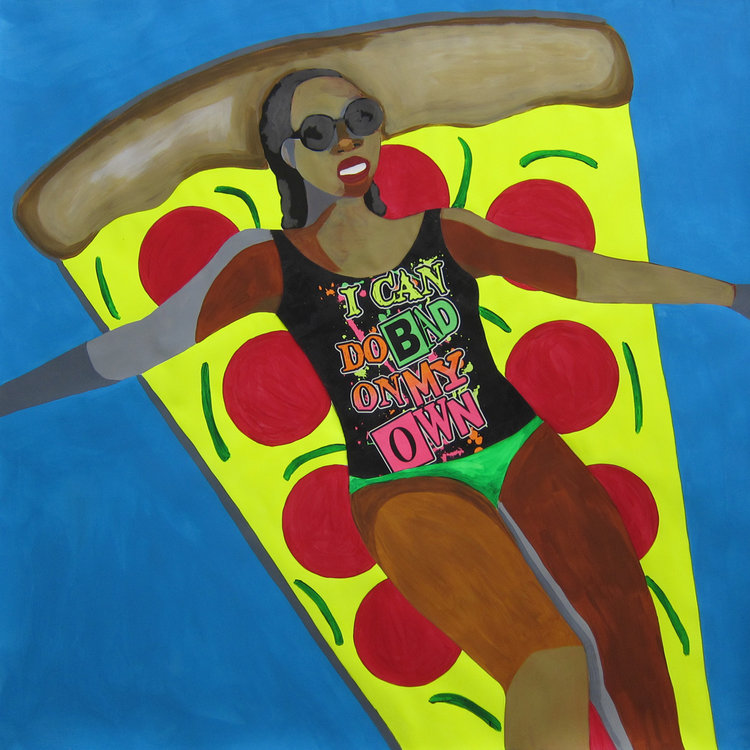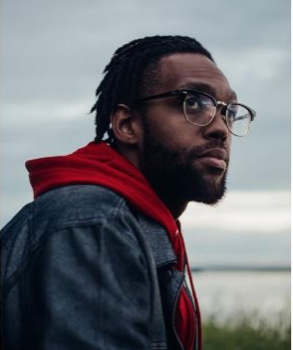Above: Derrick Adams, Floater 8 (pizza), 2016. Hero image courtesy of Derrick Adams himself.
Breathe. Breathe. During times of anxiety, people utter these words of comfort. They are a self-talk mechanism to ground us in the present and to deescalate anger and hurt. As well as breathing techniques, mindfulness or herbal remedies from places like Pure Hemp Farms can help us lower the production of stress and anxiety hormones in our bodies. Though recently it has become harder for us to manage our stress and anxiety, people have been saying that CBD products from places similar to Blessed CBD are helping them cope up. Of course, this isn’t going to be a solution for everyone around the world, so it’s always best to research before going ahead and purchasing anything. Those in the UK, for example, can find CBD oil UK laws online easily, and it’s likely to be the same wherever you are. Because of COVID, worries for our health are at an all-time high, meanwhile, the rise in white supremacy is literally trying to restrict our breathing. Though we are constricted daily, we can find solace through art and expression.
In this reality, it is important to protect our mental health against the onslaught of media violence and sustain our existence. Many Black artists document uplifting depictions of Black life. Within Black contemporary artwork, notice how we sustain ourselves through trauma. Before taking a bat in hand like Beyoncé in Lemonade, learn how to heal yourself through the art of the collective. You have agency in your own healing.
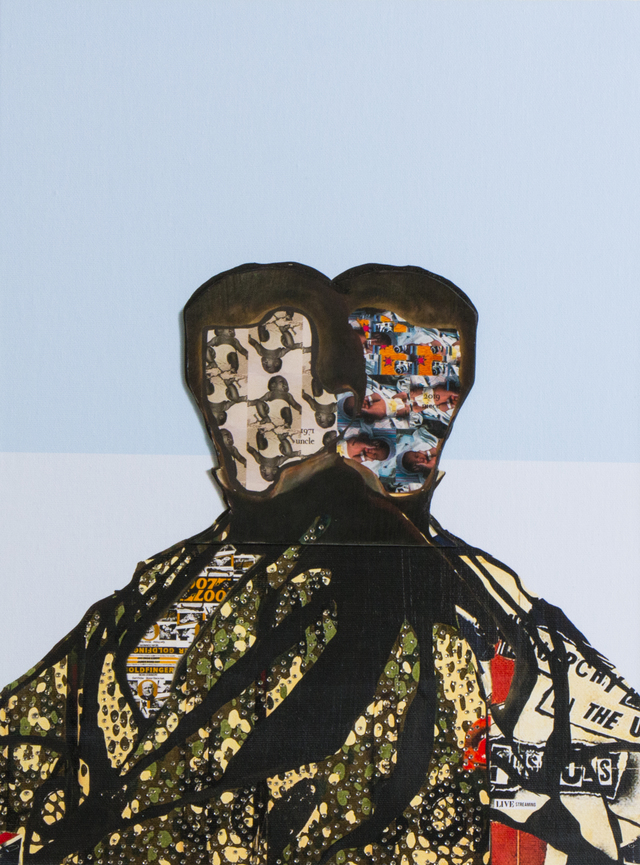
Art in Your Coping Tool Kit
Dr. Joy Harden, the host of Therapy for Black Girls and licensed mental health therapist, notes the importance of finding your coping tool kit. This tool kit looks different now than ever before-social distancing protocols feel like they separate us from the collective and cripple us from recovering from shared trauma while physically isolated. However, looking at art is one of the many ways to tap into this collective power.
In your journey, lean on artwork of the African Diaspora. During battles with anxiety and depression, you might be searching everywhere for remedies to soothe your mental pain. Perhaps you are searching for therapy, or have come across some products like those from VibesCBD to relax your mind and put you at rest from those exhausting thoughts. Just stop a second, take it slow. One step at a time. You will find there is really nothing like the wisdom of our fictive kin who create beauty from the ashes. They embolden you to change your perceptions of yourself and communicate messages of healing. In the same way, messages were coded in quilts and escape routes contained braids, crafted stories, hidden in art, are our antidote to promote healing. Use this as your healing method, absorb the calmness and the positive vibes.
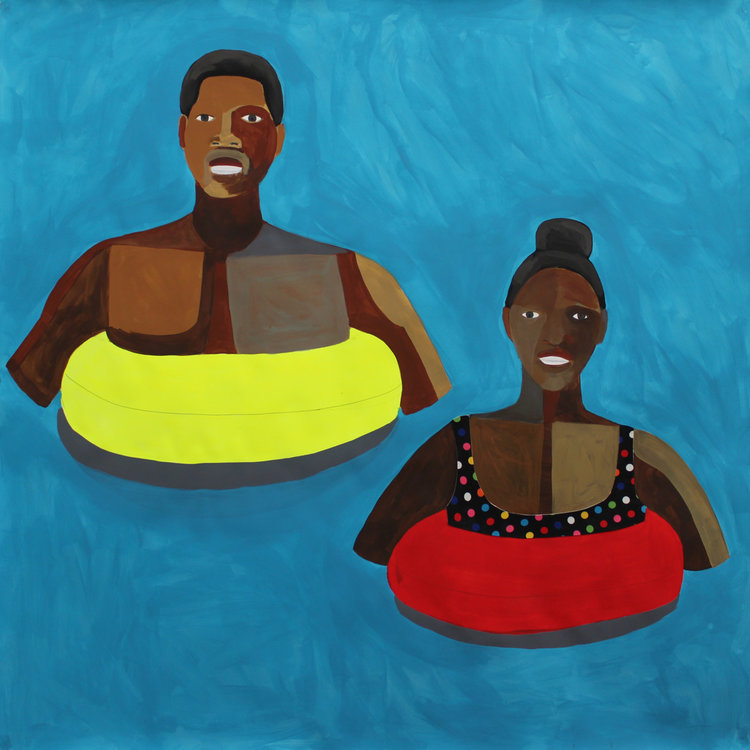
Derrick Adams’ Resistance in Joy
The primary colors and geometric forms in Derrick Adams’ 2016 series, Culture Club is reminiscent of childhood freedom and innocence. Whimsically, the color scheme, geometric shapes and the subject matter, evoke summer days jumping into the pool, eating popsicles (even though they managed to drip down your hand and stain your mouth), and singing Stevie Wonder’s “Happy Birthday” at family cookouts. His work celebrates Black joy in the summertime.
In the Power, Purpose and Privilege with Artists Nari Ward and Derrick Adams episode of In Other Words hosted by Charlotte Burns, Adams says, “I thought successful art was about penetrating the world with images that you want people to see. I want to give viewers other options of looking at Black American culture-what people are doing as a break.” Leisure in Black life is always a healing view to partake. It reminds us of what is beyond the mask and some of the joys of Black life.
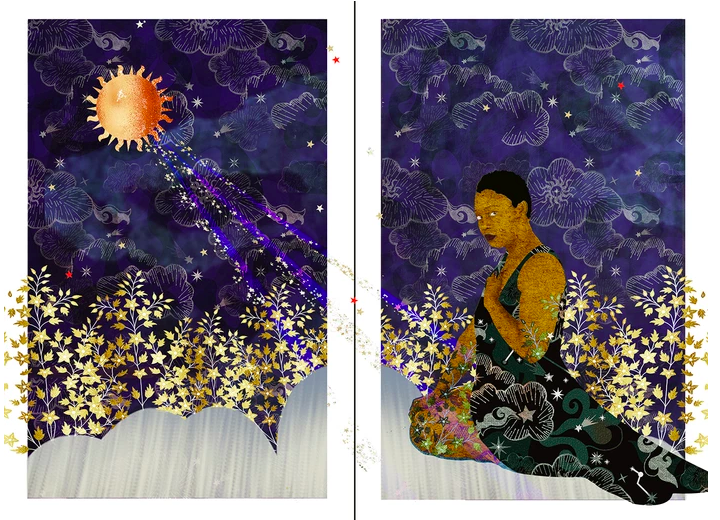
Carla Jay Harris’ Mythologizing Power
Carla Jay Harris, multidisciplinary artist and curator, offers hope, beauty and regality that transcend time and space in her Celestial Bodies series. Inspired by her childhood fascination with mythology, Harris says, her work “is a mixture of photography and design to create her own reality.” She visualizes divinity onto the Black body and spins her own folktales that empower Black people.
In Sphinx, Harris adopts the triangular form of the Egyptian architectural wonder by mimicking its composition. Her style is a fusion of Afrofuturistic concepts and Japanese Namban screens, which appropriates a colonial symbol of power and conquest. The iridescent cloud, glittery sun ray, and gold-leaf plant reference Asian-inspired motifs. Let her images of authority remind you of your royalty.

Bisa Butler’s Single Thread of Hope
Bisa Butler quilts together the textural complexity of Black portraiture. The use of the Kool-Aid color palate in her work and tactile ephemera, draw in the viewer. She layers intricate fabrics from Ghana, Nigeria and South Africa to tell the stories of her figures in a patterned space. Each person has a unique personality that exudes through the cloth.
Three Kings represents portraits of everyday people in lush color, texture, pattern, and stitched shadow. This places everyday men in a powerful stance in position to the viewer, not hiding anything but rather expressing beauty in existence. We do not know the actual identities of these men, but just interact with the visual interplay of colors and expression of their Blackness. Their stance shows them as a triumvirate-powerful, meaningful leaders.
Furthermore, look at Butler’s expressions of power and approach her work by employing mindfulness techniques through the use of visual thinking strategies. For instance, when you feel stressed, write or vocalize your answer to these questions: what do you see in this quilt, and what do you see that makes you say that? In her quilting, notice the complex patterns, textures and colors, and examine what they signify to you. Each thread offers healing as you use her work to calm your mind and focus on art in the present.
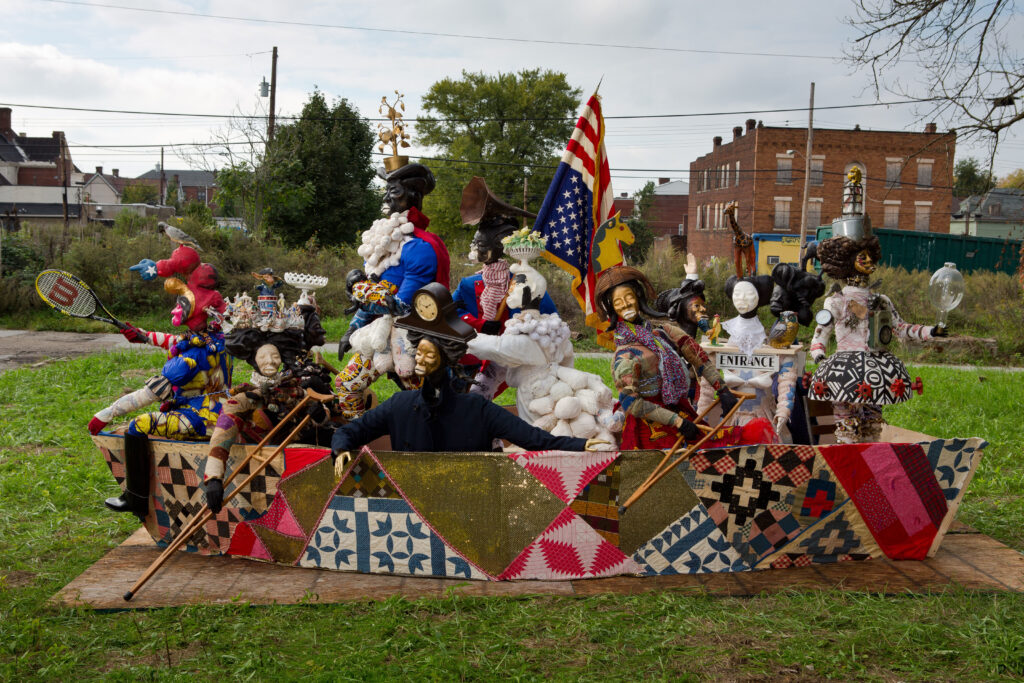
Vanessa German’s Vessels of Healing
German’s practice is about ritual healing through bricolage. She sources her media from her neighborhood of Homewood in Pittsburgh. Repurposing her environment sows seeds of healing and love, compared to the rejection and lifelessness these objects once had. She attests to the transformative power of art by saying, “Art has been transformational in my life, particularly in confronting and contending with the dimensional violence of racism. I create art works, experiences and spaces of social healing, connection, and expression.”
Partaking in the reuse of objects that symbolize the oppression of Black people becomes the spiritual embodiment of transcending those stereotypes. By recreating the American historic image of Washington, in LaQuisha Washington Crosses the Day Aware, she emphasizes the stories of Black and indigenous peoples, and gendered others as the true heroes and agents in their survival. Use her tactic of biointrospection and land cultivation to sow seeds of healing in your own physical and social landscapes.
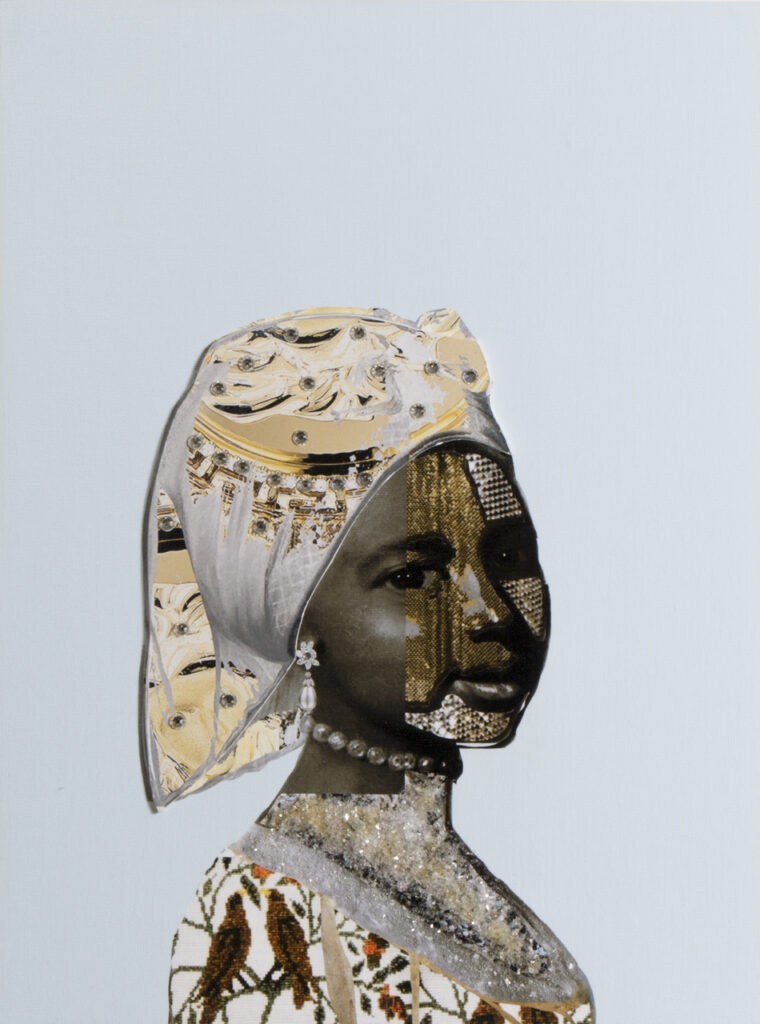
Gavin Benjamin’s Picturesque Reclamations
Rather than a fragment, Gavin Benjamin’s Neo-Baroque artwork, ascertains crucial pieces of the puzzle. His multimedia compositions express the power and legacy that Blackness carries in the face of struggle. In Heads of State, he appropriates imagery of an enslaved woman in prints and newspapers and juxtaposes her with luxury items. This act speaks volumes in reclaiming the colonized Black body and piecing together the once anonymous person’s identity into a distinguished one. With the combination of appropriated imagery, crystals, and diamonds, he asserts the value that Blackness has, despite institutional bias.
When viewing his work, reclaim your history by speaking the following affirmations to yourself:
- I am beautiful beyond measure.
- My Blackness is a mark of my royalty and history.
- My mind, soul, and spirit are healed through the work of my people, and I commit every day to preserve myself.
- My joy is important.
- There is nothing that is impossible for me because success is written in my DNA.
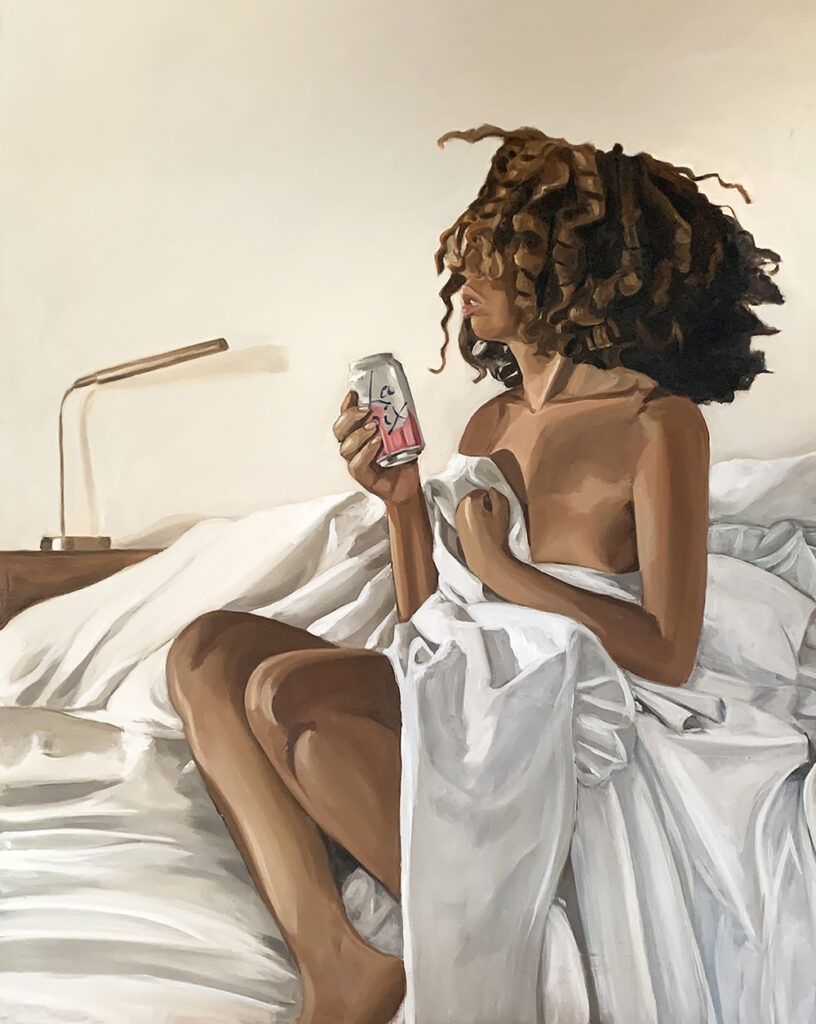
Debra Cartwright’s Visions of Solemnity
Debra Cartwright elucidates the beauty in the Black female body and the triumph that comes with the simple acts of waking up in the morning and existing. The cascading blankets and the act of drinking actually are more revolutionary than you think in this moment. Cartwright’s area of focus is the natural crowns of the women she depicts. In these intimate settings, with a tone of realism, she shows the value of just being, sleeping, and self-care. The message she reiterates is the importance in the mundane. Dismantle the visceral effects of racial trauma through maintaining a lifestyle of self-care.
Notice the coded messages that Cartwright shares with the viewer: connect with yourself and find solace in the mundane. How we can put her depictions into practice is by doing the following self-care strategies:
- Engage in meditation and mindfulness to heal racial trauma
- Journal reflections of what makes you happy, identifying triggers, and strategize healthy coping mechanisms.
- Affirm yourself through an attitude of gratitude and thank your body, soul, and mind for showing up today.
- Focus on regulating your breathing especially because the recent events try to take your breath away.
- Find a black therapist to resolve racial and COVID-related trauma.
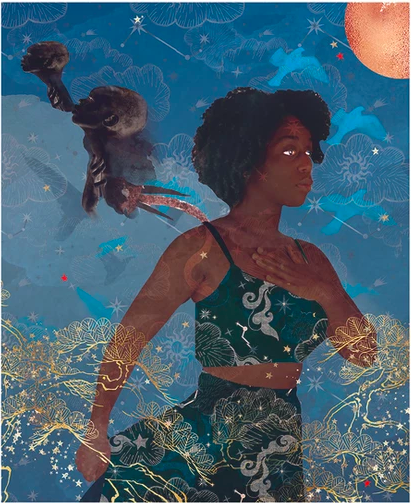
Restoration Through Art
In times of turmoil and trouble, viewing art becomes a cathartic practice. These images of Black joy are contagious and empowering. Although they do not make you forget what is going on, they reaffirm our existence and encourage healing practices. Through the self-actualization that art provokes and the employment of visual thinking strategies of the art of the African diaspora, you can heal through its beauty. Next time you feel negative emotions, glean from the messages and practice the embedded art therapy concepts. Black art exists to reflect reality and heal from it.







